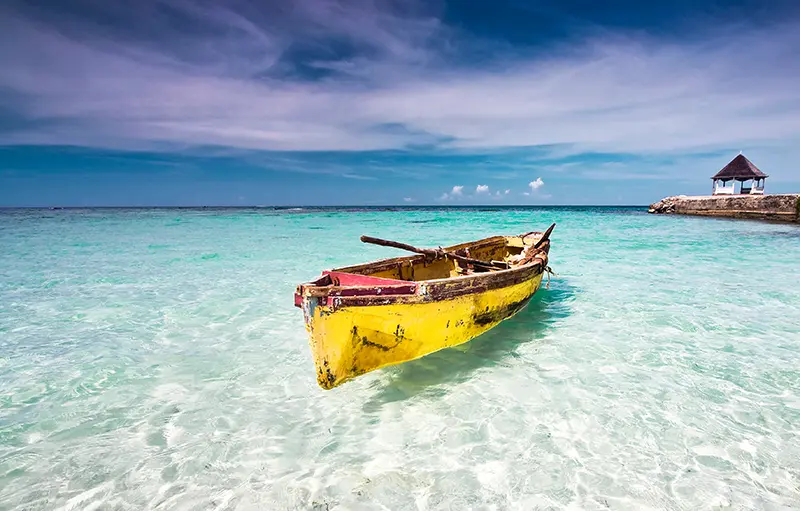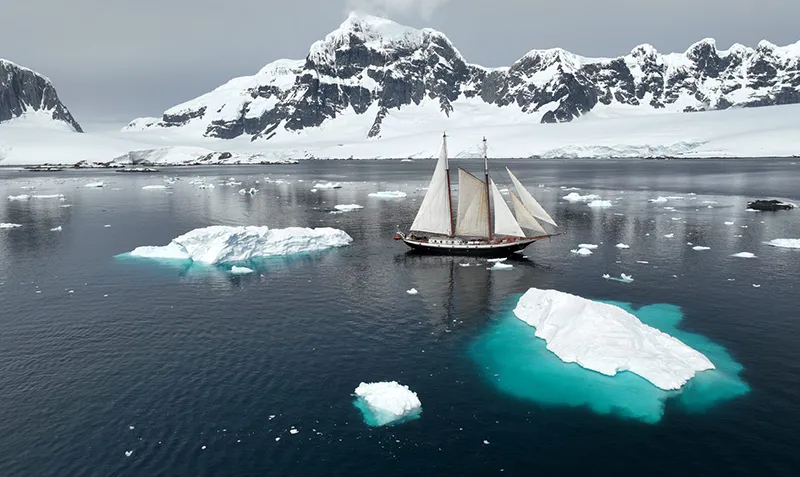The Caribbean Sea is a picturesque tropical sea in the western Atlantic Ocean, famous for its turquoise waters, coral reefs and paradise beaches. It laps the shores of many countries, including Cuba, Jamaica, Dominica and Mexico, attracting tourists with its warm climate, rich marine life, and pirate and colonial cultural heritage.
History
The first documented European contact with the Americas took place on October 13, 1492, when Christopher Columbus landed on the shore of an island he named San Salvador (today it is Watling Island, part of the Bahamas archipelago). As history has it, the exploration of the new continent by Europeans began with the islands of the Caribbean Sea, where the first European settlements appeared. From the beginning of the XVI century began the conquest of new lands, which the indigenous population did not want to cede voluntarily.
Today on the Caribbean islands there are practically no descendants of those Indians who met with the Spanish colonizers in the XVI century. By the end of the XVII century, the indigenous population of the islands was completely exterminated, and the population of the mainland coast of the Caribbean Sea was significantly reduced. But Spain already in the XVI century. had to share the loot in the New World pirates seized galleons with gold and silver coming from the Spanish colonies.
And from the XVII century in the Caribbean Sea appeared new colonizers Englishmen, who settled in Bermuda (1612), St. Kitts (1623) and Barbados (1627). The French were not long behind the English – they landed on the Caribbean island of St. Kitts just a year later – in 1624, and then in 1635 established colonies on the islands of Guadeloupe and Martinique. France and England quite successfully took away from the Spanish Empire its colonies – so, in 1655 to the English went to Jamaica, and in 1697 the French got a part of Espanola.
Around the same time, Danish and Dutch conquerors appeared in the Caribbean Sea.
Numerous islands of the Caribbean Sea became the scene of active colonization activities of Europeans – as the local population from slave labor was quickly dying out, planters began to import black slaves from Africa. The sale of tobacco and sugar cane allowed the white plantation owners of the West Indies to make huge profits.
Hurricanes and earthquakes
Tropical hurricanes, which annually visit the Caribbean Sea region, bring with them a lot of troubles – sometimes the destruction is simply catastrophic. Thus, the hurricane “Gilbert” in 1988 left a band of continuous destruction four kilometers wide and killed more than 350 people, its speed reached 320 km / hr.
And in 2004, Hurricane Jenny killed 1,314 people in Haiti. It is not surprising that the Caribbean Sea area has long been recognized as one of the most dangerous for navigation.
The Caribbean Sea basin is also a seismically dangerous zone, where the earth’s crust is shifting and geological faults are occurring. According to scientists, the lithospheric plate shifts eastward by 20 mm annually. The result of earth crust movement in the zone of collision with the North American lithospheric plate was one of the most terrible earthquakes of recent times – January 12, 2010, which almost destroyed the capital of the Republic of Haiti Port-au-Prince. According to official data, the number of dead amounted to more than 200 thousand, and injured more than 300 thousand.
The famous pirate town in Jamaica Port Royal (it was its legendary version that was created in the movie “Pirates of the Caribbean”) also became a victim of the elements. On June 7, 1692, an earthquake almost collapsed most of the city into the Caribbean Sea and the pirate capital forever ceased to terrify peaceful ships in the Caribbean Sea. Today, the remains of Port Royal are an archaeological site and a tourist attraction.
The Caribbean’s highly developed tourism industry generates huge revenues from the beauty of these places and their historical sites. However, the beautiful climate of the Caribbean Sea is combined with regular hurricanes that can destroy all life in their epicenter.
Ecology
The Caribbean Sea basin can be called “paradise on Earth” only conditionally – its natural beauty is combined with the constant danger of the elements. But human activity has also caused significant damage to the beauty of these places and their ecological well-being.
No more than 15% of the original rainforest remains on the islands today. The “contribution” of shipping is estimated at 82,000 tons of garbage per year that enters the waters of the Caribbean Sea. Disasters involving oil tankers, human waste carried by rivers into the Caribbean Sea, overuse of marine resources and the reduction of habitat for the region’s native flora and fauna are just a few of the factors that have had the greatest impact on the Caribbean Sea’s ecology.
Corals are considered to be the most sensitive to negative environmental changes. In 2008, UNESCO headquarters in Paris presented the report “The State of Caribbean Coral Reefs after the White Plague Pandemic and Hurricanes of 2005”, which reported that Caribbean reefs have lost up to 80% of their coral cover over the past 50 years. “White Plague” is a coral disease that results in white patches and coral mortality in the sea. Although scientists cite global warming as the main cause of coral death, human impact on pollution is recognized as one of the reasons for the disappearance of the natural phenomenon.
Tourism
The Caribbean Sea and its islands have long been recognized as the epitome of paradise on earth. Beautiful landscapes with golden beaches, palm trees and sky-blue water attract tourists from all over the world.
The rich flora and fauna of the Caribbean Sea, the unique history of its exploration by man, the mix of races and cultures make this corner of the globe one of the most attractive areas of mass tourism.
Today, the population of the West Indies and the entire Caribbean basin area is an amazing mix of races, peoples, languages, cultures and customs. The cuisine of this region is perhaps the richest in diversity on the globe. The tales and legends of the famous pirates and the treasures they hid in the sea are firmly embedded in the folklore of the peoples of the West Indies. Underwater search firms and solo searchers regularly find the wrecks of past centuries, and some have managed to raise real treasures from the bottom of the sea.
It is not surprising that tourism has become one of the most important pillars of the Caribbean economy. No natural disaster can deter tourists from seeing the Caribbean’s natural beauty and historical sites, relaxing on fabulous beaches and imagining themselves as true adventurers.
General information
- Official name: Caribbean Sea, marginal semi-enclosed sea of the Atlantic Ocean basin.
- Location: Between 9º and 22º N and 89º and 60º W, bounded on the west and south by Central and South America and on the north and east by the Greater and Lesser Antilles.
- Continental countries of the basin: Mexico, Colombia, Venezuela, Nicaragua, Guatemala, Honduras, Belize, Costa Rica, Panama.
- Island states and territories in the sea: Cuba, Dominican Republic, Haiti, Jamaica, Puerto Rico (U.S.), Trinidad and Tobago, Guadeloupe (France), Martinique (France), Netherlands Antilles (Netherlands), Dominica, St. Lucia, Antigua and Barbuda, Barbados, St. Vincent and the Grenadines, American Virgin Islands (USA), Grenada, St. Kitts and Nevis, Cayman Islands (UK), Aruba (Netherlands), British Virgin Islands (UK), Anguilla (UK), Montserrat (UK), St. Maarten (France), St. Barthelmy (France).
- The most important islands in the sea: Antilles, Bahamas, Cayman Islands, Turneffe Islands, Islas de la Bahia.
- Main languages spoken by the population of the countries: Spanish, English, Creole, French, Dutch.
- Religions spread in the countries of the sea: Catholicism, Protestantism, Anglicanism, Hinduism, Santeria, Voodoo Rastafarianism.
- The largest cities: Caracas (Venezuela), Havana (Cuba), Santo Domingo (Dominican Republic).
- Main sea ports: Havana, Santo Domingo, Kingston (Jamaica), San Juan (Puerto Rico), Maracaibo (Venezuela).
- The most important airports: Simón Bolívar International Airport (Caracas). Simón Bolívar International Airport (Caracas), José Martí International Airport (Havana), Maracaibo (Venezuela). Jose Marti International Airport (Havana), Las Americas International Airport (Santo Domingo).
- The most important rivers of the sea basin: Magdalena, Atrato, Turbo.
- The largest lake of the sea basin: Maracaibo.
- Main sea currents: Caribbean, North Passat, Antilles, Gulf Stream.
- Mirror area: 2,754,000 km2.
- Greatest depth: 7686 meters.
- Average depth: 1,225 meters.
Economy
- Tourism (more than 15% of all jobs in the region)
- Fishing (about 0.5 million tons of seafood per year)
- Pearl mining
- Shipping and trade
- Coastal and island agriculture: citrus, bananas, tropical fruits, rice, coffee, sugar cane, corn.
Climate and weather
- Tropical, average monthly temperatures: +23ºC … +27ºC.
- Average annual rainfall ranges from 250 mm (Bonaire Island) to 9000 mm in the windward parts of Dominica.
- In the northern parts of the Caribbean Sea, tropical storms occur annually from June to November, with an average of 8-9 per year.
Attractions
- Havana (Cuba): La Fuerza Fortress, Santa Clara Monastery, Cathedral of the Immaculate Conception, National Museum;
- Cartagena (Colombia): fortress, main square with the cathedral, St. Peter’s Church, Palace of Inquisition, University building – UNESCO World Heritage Sites;
- Santo Domingo (Dominican Republic): Osama Fortress, Tore del Omenaje Tower, Casa del Almirante Palace, Alcazar Castle, Casa de Engombe Palace, Santa Maria la Menor Cathedral;
- San Juan (Puerto Rico): Fort San Felipe del Moro, Fort San Cristobal, El Palacio de Santa Catalina, St. Joseph Church;
- Mayan city of Tulum (Mexico);
- Port Royal (Jamaica);
- Alexander Humboldt National Park (Cuba);
- Mor Trois Pitons National Park (Dominica);
- Jaragua National Park (Dominican Republic);
- Sian Ka’an Reserve (Mexico);
- Daria National Park (Panama);
- Los Catios National Park (Colombia);
- Henry Peter National Park (Venezuela).
Fun Facts
- On the very shore of the Caribbean Sea, on the Yucatan Peninsula, Mexico, is the Mayan city of Tulum, whose founding scientists attribute to 1200 AD, and neglect – to the period of the beginning of contact with Europeans – XVI century. Today Tulum, one of the best preserved Mayan cities, is the pearl of the so-called Mayan Riviera, a resort area on the eastern coast of Yucatan,
- The city of Santo Domingo, founded in 1496 in the southeastern part of the island of Haiti (initially named Española) by Christopher Columbus’ brother Bartolomeo Columbus, is the oldest permanent European settlement in the Americas. In the beginning, this settlement, which had not yet become a city, was named Nova Isabella, in honor of the Spanish queen. Attempts to establish Spanish outposts on Española had failed twice before – La Navidad and La Isabela, established in 1492 and 1494, were destroyed by the local population.




